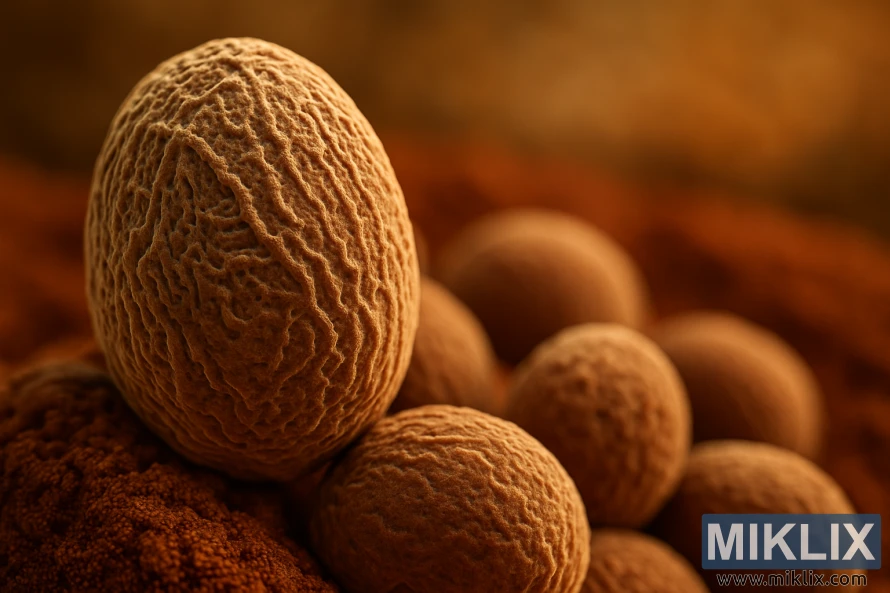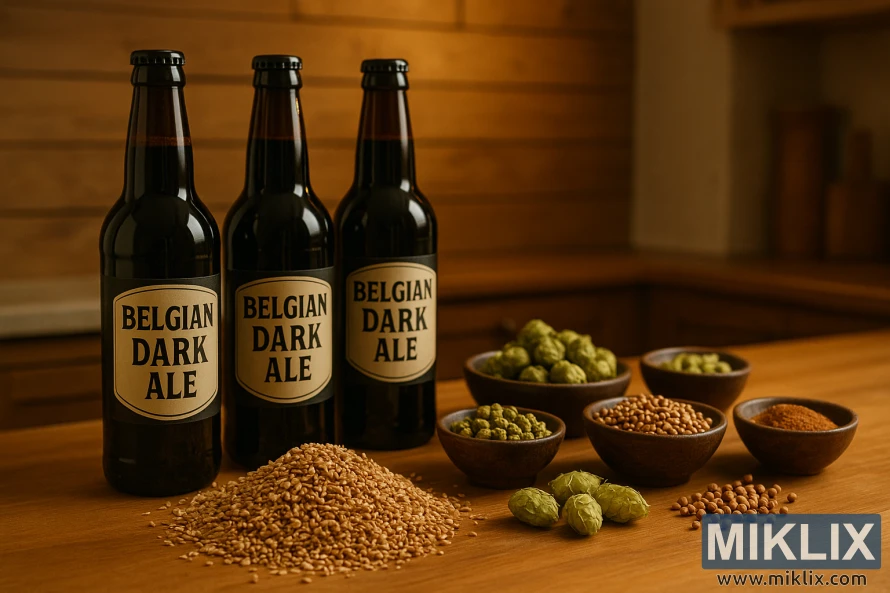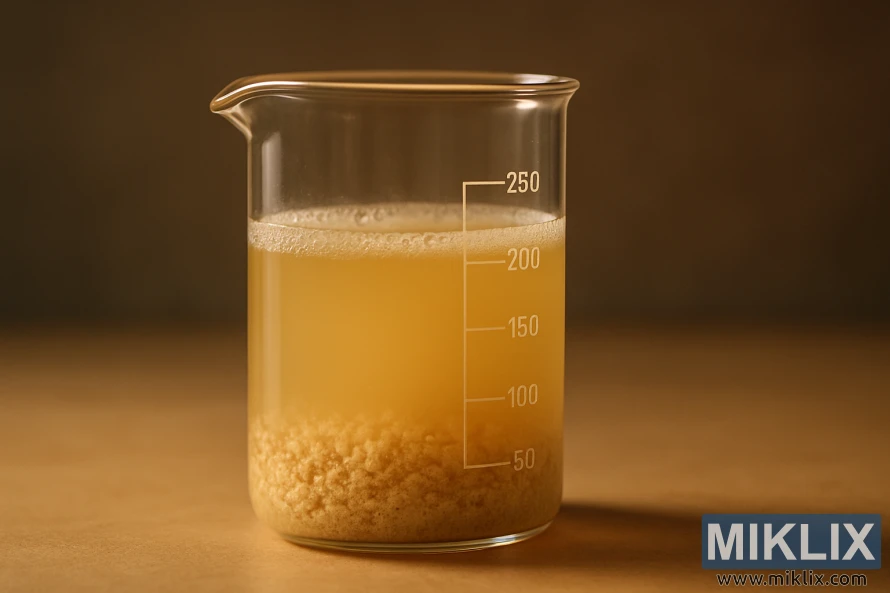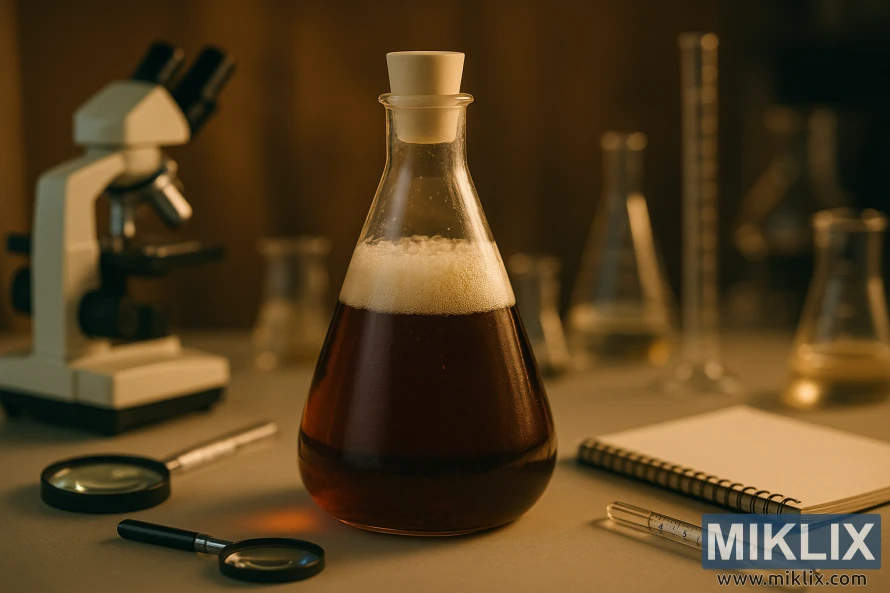Fermenting Beer with Wyeast 3822 Belgian Dark Ale Yeast
Published: October 19, 2025 at 8:51:12 PM UTC
This article delves into the use of Wyeast 3822 Belgian Dark Ale Yeast for brewing Belgian Dark Strong Ales. It's aimed at homebrewers tackling high-gravity ales. It offers detailed insights into yeast performance, flavor impact, and handling. It also covers troubleshooting during fermentation.

This article delves into the use of Wyeast 3822 Belgian Dark Ale Yeast for brewing Belgian Dark Strong Ales. It's aimed at homebrewers tackling high-gravity ales. It offers detailed insights into yeast performance, flavor impact, and handling. It also covers troubleshooting during fermentation.
Readers will discover a comprehensive profile of Wyeast 3822 Belgian Dark Ale Yeast. You'll learn about its flavor and aroma contributions, along with recipe pairings. The guide also provides advice on mash and wort preparation for large beers, pitching, and fermentation schedules. It emphasizes the importance of temperature management and final gravity expectations.
Search signals and readers will find a direct preview in the meta title and description. They focus on unlocking rich Belgian flavors with Wyeast 3822. The article compares similar Belgian strains and concludes with practical tips for consistent results using this trusted yeast.
Key Takeaways
- Wyeast 3822 Belgian Dark Ale Yeast excels in Belgian Dark Strong Ale recipes and adds complex spice and fruit esters.
- Proper pitching rates and healthy starters are essential when fermenting beer with high original gravities.
- Temperature control and a staggered fermentation schedule help tame fusel alcohols and improve attenuation.
- Mash, water chemistry, and yeast handling combine to shape final flavor and alcohol potential.
- This Belgian yeast review will guide U.S. homebrewers through troubleshooting and conditioning choices for best results.
Introduction to Wyeast 3822 Belgian Dark Ale Yeast and this product review
This piece introduces Wyeast 3822, a Belgian yeast strain, and its significance in brewing. It highlights its use in creating Belgian Strong and dark ales. The evaluation methods are also discussed, providing insights into its performance.
The review is based on homebrew logs, published recipes, and lab data. It reveals OG ranges from 1.069 to over 1.080, with some reaching 1.102. Recipes often include dark malts, molasses, or candi sugar for depth and body.
It delves into fermentation, attenuation, and flocculation. Temperature ranges, ester and phenol contributions, and the choice between starters and no-starters are examined. This provides a comprehensive view of the yeast's capabilities.
Expectations for conditioning and aging are discussed, as well as the choice between kegging and bottle conditioning. The availability of Wyeast 3822 as a liquid culture is noted, appealing to homebrewers.
The review's methodology combines user logs, recipe data, direct fermentation observations, and manufacturer specifications. This approach offers a practical understanding of Wyeast 3822's performance in Belgian dark strong ales.
Profile of Wyeast 3822 Belgian Dark Ale Yeast
The Wyeast 3822 yeast strain is designed for crafting rich, high-gravity Belgian dark ales. It boasts an average attenuation of 76% and exhibits medium flocculation. Brewers often note vigorous activity and a significant krausen during fermentation of strong worts.
For consistent results, practical handling notes are crucial. The yeast is available in liquid Wyeast packs and can be repitched from a healthy cake if timing permits. Due to its medium attenuation flocculation, some yeast will remain suspended during conditioning. This aids in secondary ester development.
Temperature guidance varies, but the optimum range for Wyeast 3822 is generally between 65–80 °F. Many recipes suggest fermenting around 70 °F for balanced ester and phenol expression. For high-gravity beers, fermenting in the mid-70s can accelerate attenuation without introducing harsh fusels.
Starter strategy is contingent on the original gravity. While some sources default to “Starter: No,” brews with OGs over 1.080 benefit from a robust starter or multiple packs. This ensures a healthy cell count, shortening lag time and reducing culture stress.
Fermentation character aligns with Belgian Dark Strong Ale styles. Expect active, sometimes prolonged primary fermentation with a robust krausen. Monitor gravity closely and allow extra time for off-flavor cleanup when fermenting at the higher end of the optimum temp range.
Summary points for brewers:
- Typical attenuation flocculation: ~76% and medium flocculation.
- Optimum temp Wyeast 3822 range: 65–80 °F; many choose ~70 °F for balance.
- Use a starter or multiple packs for worts above 1.080 to ensure cell health.

Flavor and aroma contributions for Belgian Dark Strong Ale recipes
Wyeast 3822 is a perfect match for Belgian dark strong ales, offering a unique flavor profile. It introduces spicy, clove-like phenolics and ripe fruit esters. These yeast-driven compounds are the heart of the beer's aroma.
Adding dark candi sugar or specialty malts like Special B, chocolate, and crystal enhances the yeast's contribution. The result is a beer with dark fruit and caramel notes, rather than heavy roast flavors.
Attenuation around the mid-70s leads to a dry finish, which contrasts with the beer's high alcohol content. This dryness contributes to a lighter body and cleaner mouthfeel, even in large beers.
During conditioning, the beer's aroma continues to evolve. Bottle or keg aging over weeks to months can soften harsh alcohol and reveal secondary flavors. Many brewers find their beers drinkable at six to eight weeks, with significant improvement after six months.
- Primary aromatic traits: spicy phenolics, banana and stone fruit esters
- Interaction with adjuncts: dark candi sugar highlights raisin and fig
- Mouthfeel and aging: dry finish, lighter body, benefits from long conditioning
Recipe examples that pair well with Wyeast 3822
Below are practical Belgian Dark Strong Ale recipes and hybrid ideas that take full advantage of Wyeast 3822. The first example targets a moderate original gravity near 1.075 for balanced complexity and drinkability.
- Example 1 — Chop & Brew–inspired (5.5 gal / 20 L): Pilsner malt 80.7%, Munich 10.1%, Caramel 120L 1.6%, Blackprinz 0.9%, dark candi sugar 6.7% (275°L). Hops: First Gold to ~25.5 IBU. Estimated OG ~1.075, ABV ~8.3%. Typical mash and a 90–120 minute boil help color and Maillard development.
- Example 2 — Higher-gravity “Awesome Recipe” (5.5 gal / 20 L): Pale 2-Row 61.5%, Pilsner 10.3%, Aromatic 5.1%, Crystal 150L 2.6%, Chocolate 2.6%, Special B 2.6%, Belgian dark candi sugar 15.4%. Expect OG up to 1.102, FG ~1.020, ABV ~10.9%. Keep IBUs low (~11.9) and use Styrian Goldings for delicate spice.
Brewers often use dark Belgian candi sugar to lift gravity without leaving heavy body. Use it between 6% and 15% of total fermentables in these Belgian Dark Strong Ale recipes to push alcohol while keeping drinkability.
Batch sizing in these Wyeast 3822 recipe examples assumes a 5.5 gallon brew and a 20 liter fermenter. Adjust fermentable weights for brewhouse efficiency. Longer boils, up to 120 minutes, increase color and enhance Maillard flavors.
Some brewers add adjuncts for layered complexity. Concentrated fruit purées or wine-like adjuncts work well when used sparingly. When trialing candi sugar recipes, stagger additions or dissolve sugars late in the boil to reduce caramelization loss.
For best results with Wyeast 3822, manage pitching rate and oxygenation to match the gravity of the selected recipe. Rich, high-gravity Wyeast 3822 recipe examples benefit from healthy starters and stepped temperature control during active fermentation.

Mash and wort preparation for high-gravity Belgian dark beers
Begin by selecting a mash profile Belgian dark ale that aims for a moderate body. Opt for a single-infusion mash at 66.7 °C (152 °F) for 60 minutes. This temperature is ideal for starch conversion, ensuring a smooth mouthfeel.
It's crucial to monitor mash pH closely. Aim for a pH near 5.2 at mash temperature. This pH level optimizes enzyme activity and balances extraction from Munich and base malts. Use food-grade lactic acid or brewing salts to adjust pH if necessary.
Limit specialty dark malts in the grist to avoid harsh roast notes. Special B, Chocolate, and Crystal should not exceed 2–5% each. Use pale 2-row or Pilsner as the base and add modest Munich for color and malt complexity. Dark candi sugar can be added to lift gravity and lighten body without adding roasted astringency.
Focus on sparge technique and brewhouse efficiency. Homebrew batches typically achieve efficiencies of 72–75%. Avoid rushing or using overly hot sparge water, as it can lower sparge efficiency and original gravity. Rinse gently and control sparge water temperature.
Plan your boil time Belgian strong ale to match your goals. Boils of 90–120 minutes concentrate wort, darken color, and enhance Maillard reactions. Use Irish moss or other finings late in the boil for clearer wort. Keep hop additions restrained to preserve malt and yeast character in the finished beer.
- Example mash: single infusion at 66.7 °C (152 °F) for 60 minutes.
- Mash pH target: ~5.20 at mash temperature.
- Grain bill: pale 2-row or Pilsner base, modest Munich, 2–5% specialty dark malts.
- Sugars: dark candi added to boost ABV and lighten body.
- Boil time Belgian strong ale: 90–120 minutes for color and concentration.
Lastly, taste and measure at key stages. Check mash pH after dough-in, verify pre-boil gravity, and note the impact of boil time. By paying close attention to mash and wort steps, you can achieve a cleaner fermentation and a refined Belgian dark strong ale.
Pitching rates, starters, and yeast handling best practices
For high-gravity Belgian dark ales, the correct Wyeast 3822 pitching rate is crucial. Aim to build cell counts for worts over original gravity 1.080. A single liquid pack may ferment lighter batches, but a starter or multiple packs reduces lag and stress on the culture.
Use yeast starter guidance when planning. Prepare a starter sized to the beer gravity and batch volume. A stir-plate yields the best cell growth. Keep starter temperatures moderate, in the mid-60s to low-70s °F, to avoid heat stress and to encourage healthy strains.
Practice careful liquid yeast handling during propagation and transfer. Sanitize all equipment, aerate the wort before pitching, and consider pure oxygen for very high gravities. Gentle handling preserves viability and avoids contamination.
- Estimate cells using standard pitching calculators and adjust for OG above 1.080.
- Make starters 24–72 hours ahead and cold-crash before decanting for clearer yeast slurry.
- Re-pitch yeast from a healthy cake when timing allows, keeping sanitation strict.
When reusing Wyeast liquid packs, track generation and avoid repitching after successive stressful ferments. Fresh starters improve attenuation and flavor for strong Belgian styles. Follow yeast starter guidance to match the strain's needs and your recipe goals.
Oxygenation, temperature control, and measured Wyeast 3822 pitching rate together give the best chance of a clean, active fermentation. Treat the culture respectfully and your beer will benefit from full attenuation and complex character.

Fermentation schedule and temperature management with Wyeast 3822 Belgian Dark Ale Yeast
When brewing with Wyeast 3822, plan a realistic fermentation schedule. For beers with moderate original gravity, anticipate a vigorous primary fermentation lasting 2–3 weeks. High-gravity worts, on the other hand, require more time. Brewers often observe active krausen behavior for weeks on strong ferments with gravities of 1.080–1.090.
Begin fermentation in the mid to upper 60s Fahrenheit. Experts suggest a minimum of 65 °F and an optimal range of 65–80 °F. In practice, maintaining temperatures between 68–70 °F ensures steady attenuation and controlled ester development. Cooler cellar temperatures in the low 60s will slow fermentation, extending the schedule.
Focus on signs, not the clock. Monitor krausen behavior, airlock activity, and specific gravity. Bottle only when fermentation has clearly subsided. Gravity readings will guide you on when to transition to conditioning and when packaging is safe.
Employ a two-stage approach for complex beers. Maintain an active primary at your target temperature until krausen subsides. Then, transition to a warm conditioning period near the yeast's upper limit for a few days. This step aids in finishing attenuation and byproduct cleanup. Move the beer to cooler storage for longer aging and clarity.
- Example timeline for a 1.085 wort: pitch, active krausen by day 2–4, strong activity through week 1, lingering krausen and gravity drop into week 3. Expect primary of three weeks or more.
- Temperature adjustments: if activity slows in a cool room, raise to about 68 °F to revive yeast and encourage a healthy, creamy tan krausen.
- Conditioning cues: stable gravity over 3 days signals end of primary and readiness for cooler aging.
Effective temperature management for Belgian yeast strains requires gentle control. Avoid wide temperature swings. Sudden cooling can stall secondary attenuation. Rapid warming may introduce phenolic or solvent notes. Consistent conditions help Wyeast 3822 showcase the rich, fruity-spicy profile characteristic of Belgian dark ales.
Attenuation, final gravity expectations, and alcohol potential
Wyeast 3822 typically shows solid attenuation in homebrew records. A common baseline sits near 76% attenuation Wyeast 3822. This helps many Belgian dark recipes finish fairly dry for their starting gravities.
Example outcomes vary by recipe and mash fermentability. A Chop & Brew example listed OG 1.075, measured OG 1.069, with an estimated FG 1.013 and roughly 8.3% ABV expectations. Another BrewersFriend prediction for a very big recipe showed OG 1.102 and FG 1.020, giving ABV expectations near 10.9%.
Final gravity Belgian strong ale readings depend on fermentability and adjuncts. Adding candi sugar raises overall fermentability. This can push the final gravity Belgian strong ale lower. Heavy dextrins from under-converted mash can hold FG higher.
Plan yeast handling to reach alcohol potential. For high OG beers, build a starter or use multiple packs to ensure viability. Proper pitching, oxygenation, and nutrient support increase the chance the yeast will hit target attenuation Wyeast 3822 and reach expected ABV expectations.
- Measure OG accurately and calculate target FG from your expected attenuation Wyeast 3822.
- Adjust mash schedule or add simple sugars to control fermentability and final gravity Belgian strong ale.
- Allow extended fermentation and warm conditioning to encourage yeast to finish stubborn dextrins and meet ABV expectations.
Track gravity over time rather than stopping at the first stable reading. Extended conditioning often reveals a lower final gravity Belgian strong ale. It confirms the true alcohol potential of high-gravity Belgian ales.
Conditioning, aging, and bottle vs keg considerations
Give Belgian dark strong ale time to condition. This allows harsh alcohol to mellow and esters to blend. Beers with lower gravity can be ready in 6–8 weeks for bottling.
Many brewers see a significant improvement after six months of bottle aging. This aging softens tannins, deepens the color, and enhances dark fruit and caramel flavors. These changes make the beer shine in its style.
Bottle conditioning with Wyeast 3822 provides live yeast for gradual maturation and natural carbonation. This method can introduce subtle flavor shifts and a creamier mouthfeel compared to forced CO2.
Consider the trade-offs between bottle conditioning Wyeast 3822 and kegging high gravity ales. Bottle conditioning requires more bottles and can lead to variability in carbonation levels.
Kegging high gravity ales allows for quicker service and sampling without opening many bottles. Forced carbonation offers precise CO2 volumes, speeding up the readiness for service.
- Carbonation targets: aim for moderate carbonation to complement a dry finish. Around 2.2–2.4 volumes CO2 often suits Belgian dark strong ale.
- Timing: never bottle while primary fermentation is active. Confirm gravity is stable over several days to avoid overcarbonation and bottle bombs.
- Storage: bottles can age at cellar temps (50–60°F) for months. Kegs require cool, stable storage when long aging is desired.
For practical workflow, bulk condition in a bright tank or secondary fermenter to reduce variability. Then, choose bottle conditioning Wyeast 3822 for limited runs or kegging high gravity ales for drafts and faster access.
Monitor samples periodically. Tasting at two-month intervals helps decide when to move beer to long-term storage or to release for distribution.
Common fermentation issues and troubleshooting Wyeast 3822 fermentations
Temperature is often the culprit behind slow or stalled fermentation. Wyeast 3822, for instance, slows down in temperatures below 60s°F. To rectify this, move the fermenter to a warmer location. Aim for mid-to-high 60s°F or gently warm the yeast cake.
Gently swirling or rocking the carboy can resuspend yeast cells without introducing oxygen. For high-gravity worts, ensure thorough oxygenation before pitching. Consider a larger starter to prevent fermentation issues Belgian yeast can introduce.
- Low attenuation: check pitching rate and oxygenation. Make a starter or add another pack when targeting high OG.
- Persistent krausen: medium flocculation leaves some yeast in suspension. Use gravity readings to confirm true final gravity.
- Excessive esters or phenolics: reduce fermentation temperature slightly and avoid thermal swings to tame aromatics.
Low OG or apparent efficiency drops can stem from sparge losses or unexpected boil-off. Monitor pre-boil gravity in your brew log. Adjust strike water and sparge techniques to avoid low OG in future batches.
Off-flavors like sulfur, solvent, or hot fusels indicate stressed yeast or too-warm fermentation. Stabilize temperature, ensure adequate nutrition, and use proper pitching rates. These steps are key to resolving stuck fermentation issues with Wyeast 3822.
If fermentation shows no progress for several days, take a gravity reading. If gravity remains unchanged, try gentle warming, rousing, or adding active starter yeast. Use measured, stepwise interventions to avoid creating new stresses.
For effective troubleshooting of Wyeast 3822, maintain a checklist. Focus on temperature control, oxygenation, pitching rate, gravity checks, and sanitation. These measures address common fermentation issues Belgian yeast can cause and shorten recovery time when a batch stalls.

Water, mineral profile, and mash pH tips for Belgian dark ales
Begin with a balanced water profile for Belgian dark ales. High sulfate can make hops too sharp. Instead, aim for a balance of chloride and bicarbonate to enhance malt and candi sugar flavors.
Before mashing, plan your mineral adjustments. Calcium is key for enzyme activity and yeast health. Use calcium chloride for a rounded maltiness or mix it with gypsum for hardness without metallic notes.
- Measure baseline water: know calcium, magnesium, bicarbonate, chloride, and sodium.
- Target moderate calcium, low to moderate sodium, and chloride slightly higher than sulfate.
- Account for dark candi sugar that lowers perceived mineral contribution from adjuncts.
Consider mash pH for yeast performance. Aim for a mash pH of 5.2–5.4 at mash temperature. This optimizes enzymes and reduces harshness from roasted malts.
Adjust mash pH with food-grade acids or bicarbonate with care. Dark malts tend to raise pH. Small amounts of lactic acid often work better than large bicarbonate doses, which can taste alkaline.
Sparge and dilution water are crucial. High bicarbonate sparge water can extract harsh tannins from dark malts. Use treated or adjusted sparge water to protect color and flavor.
- Check sparge water alkalinity and adjust to avoid tannin extraction.
- Calculate dilution water to hit target gravity without upsetting mineral balance.
- Re-measure pH after any major water change and tweak mineral adjustments as needed.
Document every change and test in small batches first. Thoughtful mineral adjustments and careful control of mash pH Belgian yeast strains respond well to. This will yield a smoother, richer Belgian dark ale.
Equipment and packaging recommendations for high-gravity brews
Choose fermenters with ample headspace for krausen and aging. For 5.5 gal (20 L) batches, a 7–8 gal fermenter for primary and a 6 gal conditioning vessel are ideal. This setup keeps yeast in reserve and simplifies yeast management.
For worts over 1.080, a dedicated oxygenation system or a quality aeration stone with an oxygen cylinder is essential. Adequate dissolved oxygen is crucial for clean fermentation with Wyeast 3822 and similar strains. A flowmeter and check valve ensure consistent and safe aeration.
When targeting high original gravities, use a stir plate and larger Erlenmeyer flasks for starters. Multiple Wyeast packs or a stepped propagation plan reduce yeast stress. Keep a calibrated hydrometer, sanitized pipettes, and sterile flasks ready for yeast management.
- Fermenter sizing: allow ~20–25% headspace for vigorous activity.
- Oxygenation: oxygen kit with regulator or high-quality aquarium stones with an oxygen tank.
- Propagation tools: stir plate, 2–4 L flasks, or multiple yeast packs for OG >1.080.
Match your packaging methods to your storage plans for Belgian strong ales. For bottling, use bottles rated for higher CO2 pressure and confirm final gravity stability before priming. Heavy-duty crown caps and reliable bottling brushes reduce contamination risk.
Kegging is ideal for cellaring and batch rotation. Cornelius kegs with CO2 tanks enable forced carbonation, freeing up fermenters for new brews. Ensure keg seals, pressure relief valves, and a manometer are in good condition for safe handling.
Store in a cool, dark cellar or a temperature-controlled fridge for long-term storage. Many brewers store Belgian strong ales around 50–68 °F for months to mellow harsh esters. Move kegs or bottles to a slightly warmer space near the end of conditioning to help any remaining yeast finish slowly.
Prioritize durable, easy-to-clean gear from trusted brands. Stainless steel fermenters, quality oxygen regulators, and proven yeast management gear reduce variables in high-gravity brewing. Solid equipment choices protect both the beer and the brewer’s schedule.
Comparative reviews: Wyeast 3822 vs similar Belgian strains
Brewers often weigh performance, flavor, and tolerance when choosing between Belgian yeast strains. The Wyeast 3822 comparison is crucial for those brewing dark strong ales. This strain achieves moderate-to-high attenuation near 76% and exhibits medium flocculation.
In practical brewhouses, Wyeast 3822 performs best around 65–70 °F. This temperature range offers a balanced mix of ester and phenol character. It distinguishes itself from some Trappist strains, which produce heavier esters at lower temperatures.
Flavor contrasts are evident in tasting panels. Wyeast 3822 leans towards dark-fruit esters and a relatively dry finish. Other Belgian strains may emphasize clove, banana, or brighter fruit notes, depending on yeast lineage and fermentation schedule.
- Attenuation: 3822 sits in the higher range, offering a dryer body than many Abbey-type yeasts.
- Temperature tolerance: overlaps with peers, but yields best balance slightly below the strain’s upper limit.
- Use cases: ideal when dark-fruit esters and aging stability are priorities.
When exploring Belgian strong ale yeast alternatives, assess how a strain handles candi sugar and high gravity. Wyeast 3822 accepts adjuncts without losing its core profile. This makes it versatile for blended recipes and barrel aging.
For brewers choosing between strains, consider desired fruitiness, spiciness, and final dryness. The Wyeast 3822 comparison against other Belgian yeast strains reveals it as a middle path. It is expressive yet restrained, suited to robust dark ales that require aging and complexity.
Conclusion
Wyeast 3822 Belgian Dark Ale Yeast is a top choice for brewing Belgian Dark Strong Ales. This yeast offers about 76% attenuation, medium flocculation, and an optimal temperature range of 65–80 °F. It produces complex flavors of dark fruits, caramel, and spices, finishing dry with the use of dark candi sugar and specialty malts.
To achieve the best results, follow the best practices for brewing Belgian dark ales. Start with a sufficient starter or multiple packs for gravities over 1.080. Oxygenate the wort before adding the yeast. Aim for fermentation temperatures between 68–70 °F to balance esters. Also, ensure mash pH is near 5.2 and adjust water chemistry for better malt clarity and mouthfeel.
Maturation time is crucial. Allow at least 6–8 weeks for the beer to mature. For peak complexity, plan for several months. Bottle conditioning is ideal for traditional aging and gifting, but check final gravity stability first. Kegging offers faster service and easier long-term storage, useful for managing multiple batches.
With proper pitching rates, temperature control, and mash and water management, Wyeast 3822 can create robust, cellarable Belgian dark ales. This review and the provided checklist offer a practical guide. They are invaluable for both home and small commercial brewers looking to brew high-quality Belgian dark ales at a lower cost.
Further Reading
If you enjoyed this post, you may also like these suggestions:
- Fermenting Beer with Lallemand LalBrew Diamond Lager Yeast
- Fermenting Beer with Lallemand LalBrew Voss Kveik Yeast
- Fermenting Beer with Bulldog B38 Amber Lager Yeast
